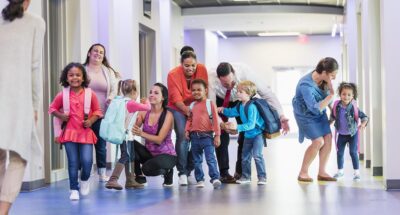

Module Introduction
As educators we must build bridges between school and the home by providing opportunities for parents, caregivers, and families to be involved in their child’s education. Systemic SEL invites us to move beyond involvement, center relationships, and enact a partnership model in which families and educators work together to support student social, emotional, and academic development, each with important and complementary roles.
In this module, we explore Family and Community Engagement (FCE) as an essential part of school-wide social and emotional learning that focuses on whole child development.
We will:
- Understand how major stakeholders view family and community engagement and SEL
- Explore practical ways that schools engage in authentic partnerships with families and communities
- Examine the ways having a culturally responsive lens is essential to effective FCE and SEL
- Consider how to develop partnerships with families and communities around SEL
Family Involvement and Engagement
The California Department of Education makes the distinction between family and involvement and engagement in the following ways:
Involvement may include “[s]ending home flyers about meetings and activities, recruiting chaperones for field trips, soliciting parents’ help with fundraisers” which “contribute to a school, but may result in low parent engagement, and may not make a substantial impact on students learning and thriving.”
“Effective family and community engagement is an intentional and systemic partnership of educators, families, and community members. These partners share responsibility for a student’s preparation for school, work, and life, from the time the child is born to young adulthood. To build an effective partnership, educators, families, and community members need to develop the knowledge and skills to work together, and schools must purposefully integrate family and community engagement with goals for students learning and thriving.”
Partner with Families and Community
In California’s Social and Emotional Learning Guiding Principles (2017), Guiding Principle number four and its sub-principles focus on the role of families, communities, and partnerships in promoting SEL:
Maximize the resources of the entire school community, including expanded learning opportunities, early learning and care programs, and family and community partnerships, to advance SEL and student well-being.
- Family Engagement: Provide families with options for meaningful contributions to, and participation in, their child’s learning experience to build respectful, mutually beneficial relationships.
- Expanded Learning: Establish shared goals across all youth serving settings, such as after school programs and summer learning programs, to leverage capacity and increase shared responsibility for positive student outcomes.
- Early Learning: Consider the inclusion of early learning and care programs as SEL systems are developed.
- Community Partnerships: Address the basic needs of students and families, including social and emotional well-being, through partnerships with community-based organizations and other stakeholders.
Module Resources
This toolkit includes additional resources, including classroom lessons and practices, staff meeting activities, videos, podcasts, articles, and professional development opportunities, as well as supporting materials for group facilitation on the topic of "Supporting SEL through Family and Community Engagement".
Individual Exploration
Social Emotional Learning with Families: From Involvement to Partnership
Families, caregivers, and communities are included in the key settings or “rings” around the five core competencies in CASEL’s systemic SEL framework, adopted widely across the state. In 2020, CASEL updated the framework to separate families and caregivers (authentic partnerships) from communities (aligned learning opportunities) in acknowledgement of their important and distinct roles.
Watch this video from Think PBS in partnership with CASEL, Montgomery County Educational Services Center, and Ohio Department of Education on Cultivating Authentic Family Partnerships.
Reflection
- What stands out to you?
- How do YOU view Family and Community engagement?
- What are the most effective ways you partner with caregivers and families to support the social and emotional well-being of your students?
This article from Harvard Graduate School of Education that offers ideas for schools to support FCE around SEL and for families to support their child’s social and emotional skill building at home.
Reflection
- What are the strengths of this article? What is missing?
- Are there ideas or practices mentioned in the article that you/your school/your district currently engage in?
- Are there any practices or ideas that you’re not currently using that you’d like to try?
- Think about the section titled “For Families: SEL Practices That Continue the Work of Schools.” Do you feel these suggestions would work for your learning community? Why or why not?
- Using a culturally responsive lens, how might you adapt and apply some of these suggestions?
6.1 Take It Deeper: Social Emotional Learning with Families: From Involvement to Partnership
Let’s deepen our understanding of Social and Emotional Learning with families and community. Here is a downloadable interactive pdf to help you.
County Office of Education Spotlight
Alameda County Office of Education partnered with Higher Expectations Parental Services to create Building Capacity: Home-School Connection Capacity Building Series. The series objective is to elevate partnerships as a model for building the capacity of families and staff in ways that lead to equity, social justice, strong home-school partnerships, and social and emotional learning.
Module Resources
This toolkit includes additional resources, including classroom lessons and practices, staff meeting activities, videos, podcasts, articles, and professional development opportunities, as well as supporting materials for group facilitation on the topic of "Supporting SEL through Family and Community Engagement".
A reflection activity to help your understanding of Social and Emotional Learning with families and community.
Group Facilitation
Before facilitating groups, spend time in individual exploration in order to experience and embody the learning. And if you haven’t yet explored our introduction to SEL in California, make sure you explore those resources, too.
When facilitating groups, use the following resources:
This toolkit includes additional resources, including classroom lessons and practices, staff meeting activities, videos, podcasts, articles, and professional development opportunities, as well as supporting materials for group facilitation on the topic of "Supporting SEL through Family and Community Engagement".
A revisable, turnkey powerpoint slide deck to use for professional learning sessions on the topic of "Supporting SEL through Family and Community Engagement".
A powerpoint slide deck with welcoming and closing activities to include in professional learning sessions.
A reflection activity to help your understanding of Social and Emotional Learning with families and community.
Additional Modules
Supporting SEL through Family and Community Engagement
- Module 6.1 Exploring Family and Community Engagement with an SEL Lens
- Module 6.2 Building Partnerships with and Honoring the Contributions of Diverse Families
- Module 6.3 Listening and Communicating Effectively with Families
- Module 6.4 Expanded Learning and SEL: Collaborating Across In-School and OST Contexts
- Module 6.5 Aligning around SEL Through Community Partnerships

Do you want to dive deeper into the science behind our GGIE practices? Enroll in one of our online courses for educators!


Comments